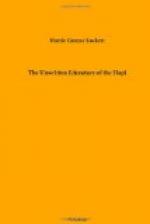At last comes the event for which the thronged village has been waiting for hours, and for which some of the white visitors have crossed the continent. Just before sundown the Antelope priests file out of their kiva in ceremonial array—colorfully embroidered white kilts and sashes, bodies painted a bluish color with white markings in zigzag lines suggestive of both snakes and lightning, chins painted black with white lines through the mouth from ear to ear, white breath feathers tied in the top of their hair, and arm and ankle ornaments of beads, shells, silver, and turquoise. (See Figure 9.) Led by their chief, bearing the insignia of the Antelope fraternity and the whizzer, followed by the asperger, with his medicine bowl and aspergill and wearing a chaplet of green cottonwood leaves on his long, glossy, black hair, they circle the plaza four times, each time stamping heavily on the sipapu board with the right foot, as a signal to the spirits of the underworld that they are about to begin the ceremony. Now they line up in front of the Kisa, their backs toward it, and await the coming of the Snake priests, for these Antelope priests, with song and rattle, are to furnish the music for the Snake Dance.
There is an expectant hush and then come the Snake priests, up from their kiva in grim procession, marching rapidly and with warlike determination. You would know them to be the Snake priests rather than the Antelope fraternity by the vibration of their mighty tread alone, even if you did not see them. Their bodies are fully painted, a reddish brown decorated with zigzag lightning symbols and other markings in white. The short kilt is the same red-brown color, as are their mocassins, the former strikingly designed with the snake zigzag and bordered above and below this with conventionalized rainbow bands.
Soft breath feathers, stained red, are worn in a tuft on the top of the head, and handsome tail feathers of the hawk or eagle extend down and back over the flowing hair. A beautiful fox skin hangs from the waist in the back. Their faces are painted black across the whole mid section and the chins are covered with white kaolin—a really startling effect. Necks, arms, and ankles are loaded with native jewelry and charms, sometimes including strings of animal teeth, claws, hoofs, and even small turtle shells for leg ornaments, from all of which comes a great rattling as the priests enter the plaza with their energetic strides.
Always a hushed gasp of admiration greets their entrance,—an admiration mixed with a shudder of awe. Again the standard bearer, with his whizzer or thunder-maker, leads, followed by the asperger, and we hear the sound of thunder, as the whizzer (sometimes called the bull-roarer) is whirled rapidly over the priest’s head. The chapleted asperger sprinkles his charm liquid in the four directions, first north, then west, south, and east.




